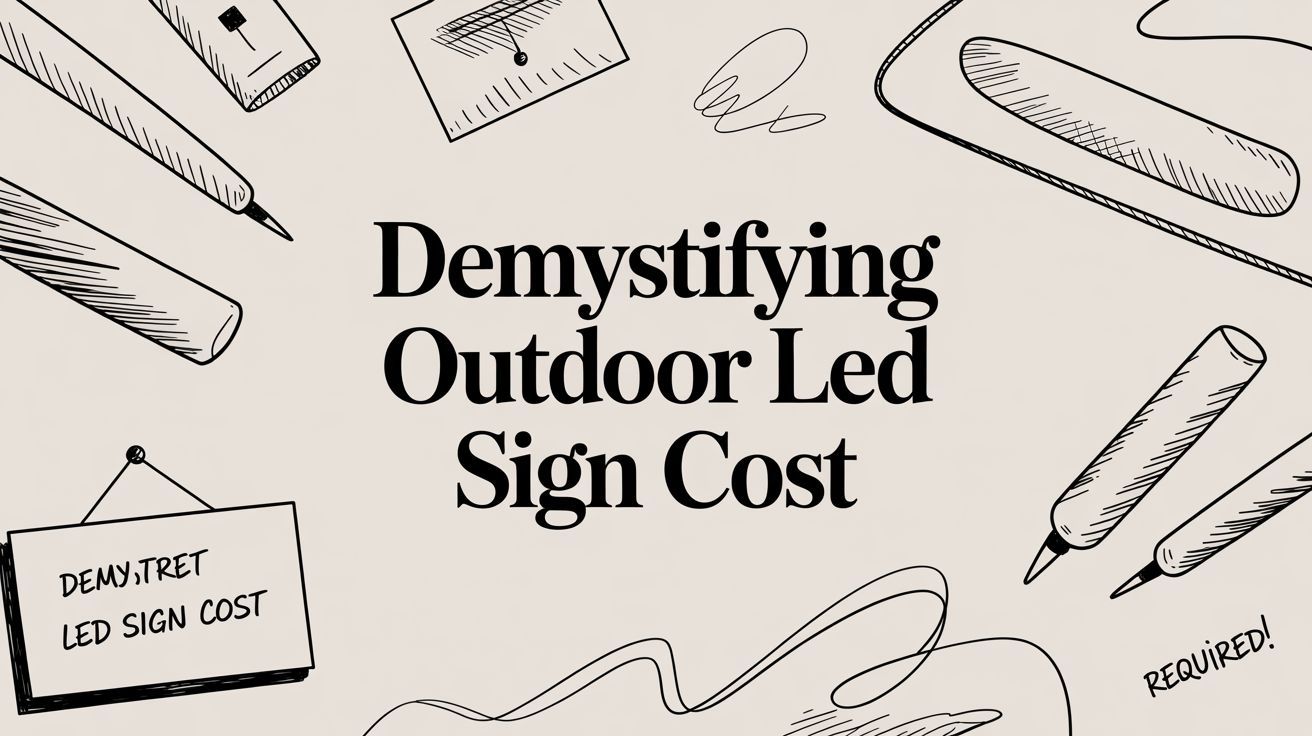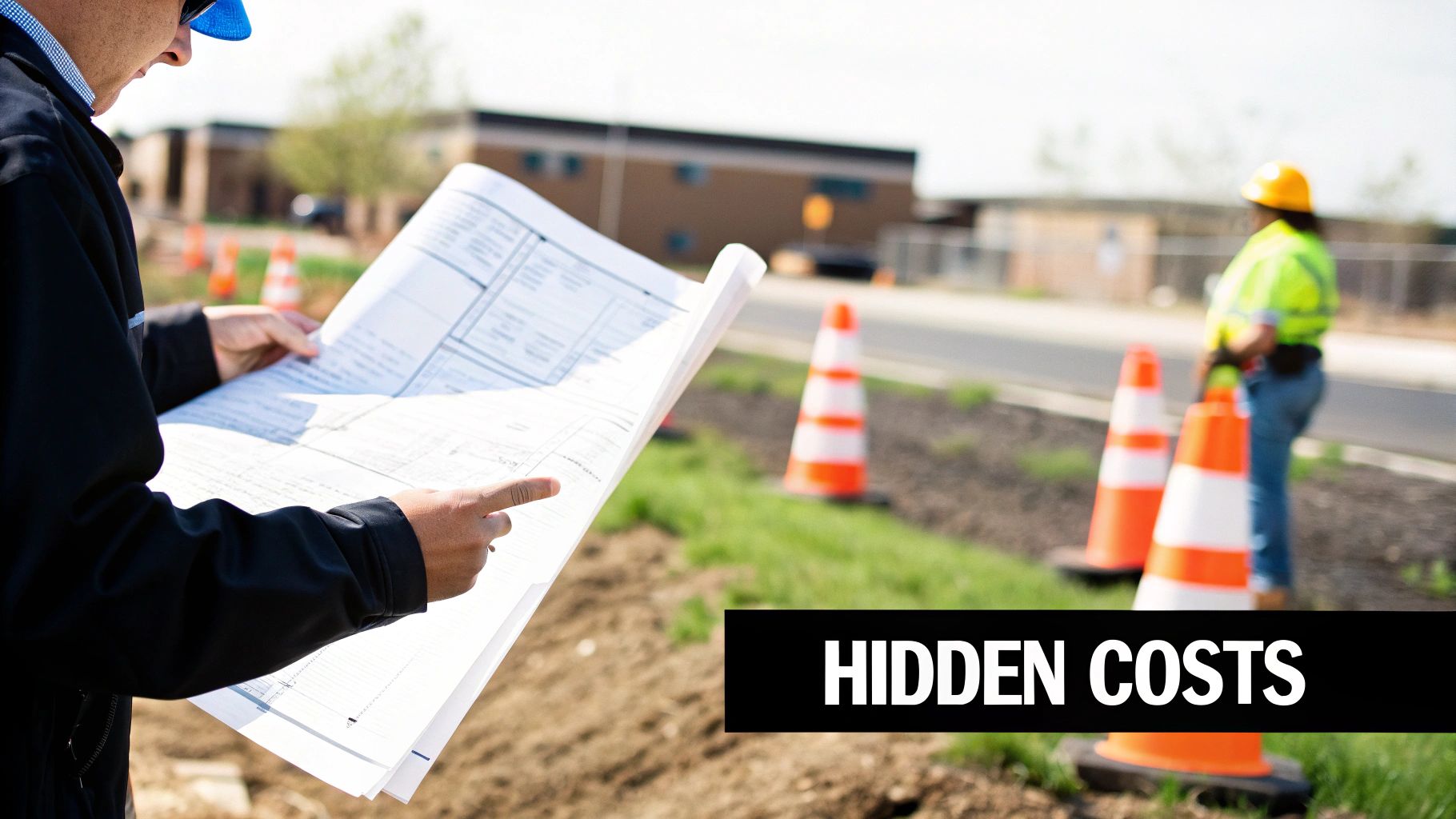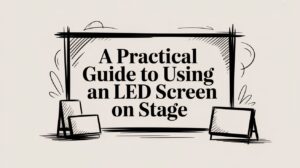
Led Light Wall Panels: led light wall panels Guide to Transform Your Space
Think about the walls around you. For most of history, they’ve been static, passive surfaces. But what if a wall could come alive? What if

So, what’s the real cost of an outdoor LED sign? The short answer is, it varies. A lot. You could be looking at anywhere from $10,000 to over $80,000. For a high-quality, double-sided sign, a realistic budget often lands somewhere between $15,000 and $60,000 once you factor in installation.
The final number on the quote comes down to three big things: the sign’s physical size, its resolution (also known as pixel pitch), and how complicated the installation will be.
To really get a handle on the total cost, you have to look past the price tag on the sign itself. That initial quote? It’s just one piece of the puzzle.
Think of it like buying a new car. The sticker price is your starting point, but it’s not what you actually pay. You still have taxes, dealership fees, and any upgrades you want. It’s the same with an LED sign—things like preparing the site, pulling permits from the city, and running new electrical lines can add a surprising amount to the final investment.
If you’ve ever looked into other major business upgrades, you’ll see a similar pattern. For instance, understanding business security system costs reveals a whole world of variables beyond the cameras themselves. Getting familiar with this kind of breakdown helps set the right expectations for your sign project.
This infographic gives a great visual of how costs scale up for different project sizes.

As you can see, the investment grows quickly with the sign’s size and the kind of impact you want to make. It can be anything from a relatively modest purchase to a major capital expense.
To give you a clearer picture, here’s a table with some ballpark figures based on common sign sizes and resolutions.
This table provides a snapshot of potential costs for common outdoor LED sign configurations, showing how price scales with both physical dimensions and pixel density.
| Sign Dimensions (Height x Width) | Typical Pixel Pitch | Estimated Cost Range |
|---|---|---|
| 3′ x 5′ | 10mm | $10,000 – $18,000 |
| 4′ x 8′ | 8mm | $22,000 – $35,000 |
| 5′ x 10′ | 6mm | $40,000 – $60,000 |
| 6′ x 12′ | 6mm or 8mm | $55,000 – $80,000+ |
Keep in mind these are just estimates. Your final cost will depend on the specific features and installation requirements of your project.
Before we get into the nitty-gritty, let’s quickly touch on the main things that will shape your quote. These are the core elements that create that wide price range you’ll see when you start shopping around.
Every business owner needs to have these four critical factors on their radar:

When you get a quote for a new outdoor LED sign, the hardware itself is going to be the biggest chunk of the price, typically making up 60-70% of your total investment. This is where the real magic happens, but it’s also where you’ll see the widest price swings between different signs and suppliers.
Think of it like spec’ing out a new truck. You can go with the base model engine or upgrade to the V8. You can stick with the standard wheels or spring for the premium alloy package. Each choice has a direct impact on performance and price, and the exact same principle applies to the core components of your LED sign.
So, let’s pop the hood and see what you’re really paying for. A few key pieces of the puzzle determine how your sign will look, how it will perform, and whether it will stand up to years of sun, rain, and snow.
If there’s one single factor that has the biggest impact on your sign’s hardware cost, it’s the pixel pitch. That might sound technical, but it’s a pretty simple concept. It’s just the distance, measured in millimeters, from the center of one LED to the center of the next one.
The smaller the pixel pitch, the closer the LEDs are packed together, which means a higher resolution and a sharper image.
It’s just like the difference between an old standard-definition TV and a new 4K screen. The 4K TV packs way more pixels into the same space, giving you a crystal-clear picture. For LED signs, it breaks down like this:
This is why a relatively small, high-resolution sign for a shopping plaza can easily cost as much as a much larger, lower-resolution billboard on the highway. You’re paying for that pixel density. And for businesses that need that extreme clarity up close, new tech like fully sealed waterproof panels is making even ultra-fine pitches a durable option for the outdoors.
Of course, a sign is more than just a bunch of tiny lights. The hardware cost also covers the critical components that protect your investment and make it all work.
The cabinet is the rugged housing that protects all the sensitive electronics from the elements. For an outdoor sign, a high-quality, weatherproof cabinet isn’t just nice to have—it’s absolutely essential. It has to be sealed tight against rain, dust, and humidity while also being engineered to let heat escape. Cheaper signs often cut corners here, and that’s a fast track to premature failure from moisture damage or overheating.
Then you have the control system, which is basically the brains of the operation. This is the hardware and software that takes your content—your ads, your messages, your videos—and tells every single LED what to do. Systems can range from simple asynchronous setups (where you upload content to play on a loop) to sophisticated synchronous systems that can stream live video. The more powerful and flexible the control system, the more it will add to the cost.
Your LED sign is only as reliable as its weakest link. Skimping on the cabinet or control system to save a few bucks is a mistake. It’s the difference between a sign that’s a workhorse for a decade and one that becomes a constant headache.
Finally, you need a way to actually create and schedule your content. The software that lets you do this is a key part of the package. Some companies roll lifetime software access into the hardware price, but others use a subscription model with monthly or annual fees. Be sure to ask about this, because those recurring fees can add a surprising amount to the long-term cost of owning the sign.
As you break down the hardware costs, it helps to think about the big picture of a professional installation. A good professional LED lighting installation guide can offer some great context on the technical side of things. By getting a handle on these hardware fundamentals, you’ll be able to compare quotes intelligently and ask vendors the right questions, ensuring you get the best possible sign for your specific needs.

That first quote for your new outdoor LED sign? It’s a big number, but it’s really just the tip of the iceberg. Too many business owners get blindsided by all the other expenses needed to get a sign out of the shipping crate and working for their business. These aren’t sneaky “hidden” fees—they’re just necessary parts of a professional construction project.
Think of it this way: buying the sign is like buying a powerful engine for a custom car. You still have to buy the chassis, the wheels, and pay a skilled mechanic to put it all together. To build a budget that won’t give you any nasty surprises, you have to look at the whole picture: pre-installation and the installation itself.
Getting this planning phase right is absolutely crucial. There’s no denying the demand for digital signage is exploding. The outdoor LED display market was already valued at around USD 7.87 billion back in 2022 and is on a steep upward climb. This incredible growth proves how effective these signs are, but it also means more cities are putting stricter rules in place for installing them. You can get more insights on the global outdoor LED market’s rapid expansion over at Persistence Market Research.
Before anyone even thinks about digging, a whole series of steps has to happen first. These are the things that make sure your sign is safe, legal, and built to last. Cutting corners here can lead to massive fines or, even worse, a structural failure down the road.
It usually starts with a site survey, where pros come out to your property to find the perfect spot, check for buried utilities, and see what the soil is like. That’s followed by a structural engineering report—a formal document that proves your sign’s foundation and design can handle the local wind and weather.
Honestly, navigating the city bureaucracy is often the most unpredictable part of the entire project. One permit can bounce between multiple departments, each with its own fees and timelines. This is where having an experienced sign partner really pays off.
Once the engineering is solid, it’s time to get permits from your local municipality. This is where things can get complicated, fast.
With the paperwork finally out of the way, the physical work can begin. How complex this stage is becomes the biggest wild card in your outdoor led sign cost outside of the sign itself. It’s not unusual for installation to add $5,000 or more to your total bill, depending on what needs to be done.
A typical installation involves a few key parts, and each one has a price tag. You should expect to see items like these on your final installation invoice:
By understanding these essential steps, you can look past that initial hardware quote and put together a realistic financial plan for the entire project, making sure there are no shocks along the way.

An outdoor LED sign isn’t a static, one-and-done purchase. It’s an active marketing asset, and to really understand the total investment, you have to look past the upfront price tag. The recurring operational costs are what truly define the total cost of ownership over your sign’s lifespan.
Think of it like buying a delivery truck for your business. You wouldn’t just budget for the vehicle itself; you’d also have to account for gas, insurance, and regular oil changes. Your LED sign is no different—it needs a steady budget for electricity, maintenance, and software to keep it running smoothly and, most importantly, profitably.
The most significant recurring expense you’ll face is electricity. An LED sign is a powerful piece of electronics, and its energy consumption can definitely make a dent in your monthly utility bill. But the good news is that this cost is far from fixed and is something you can manage.
Three big factors drive your sign’s energy use:
Even though high-quality LED signs are built like tanks, they aren’t completely invincible. Just like any other piece of equipment that lives outdoors, they need a little TLC to perform at their best. Trust me, proactive maintenance is always cheaper than a frantic, last-minute emergency repair.
Your maintenance plan should cover a few key things:
The final piece of the operational puzzle is the software. Your sign needs a content management system (CMS) to schedule and push out your ads, and the cost for this can vary wildly from one company to the next.
Some manufacturers wrap lifetime software access into the initial price of the sign, which is a fantastic long-term value. Others use a subscription model, charging monthly or annual fees that can add up to $900 – $3,600 per year.
The growth in this market is frankly staggering. The outdoor LED display market was valued at USD 7.24 billion in 2022 and is on track to explode to USD 23.38 billion by 2030. This boom, fueled by just how effective these signs are, is pushing more advanced software solutions—and some of them come with those recurring fees. Always ask any potential vendor to break down their software costs so you don’t get hit with a surprise bill.
It’s easy to look at an outdoor LED sign as just another line item in the budget. A big one, at that. But that’s the wrong way to think about it. An LED sign isn’t a cost; it’s a dynamic, revenue-generating asset. The real magic happens when you shift your mindset from the initial outdoor led sign cost to its long-term value. Calculating your Return on Investment (ROI) is what turns this purchase from an expense into a powerful tool for growth.
The value your sign delivers isn’t always as simple as a direct sale. It comes in two powerful forms: direct returns, which are the dollars and cents you can easily track, and indirect returns, which build your brand’s reputation and secure your long-term success.
Let’s start with the easy part: the direct ROI. This is the new money your sign actively brings through the door. Think of your LED display as your most dedicated salesperson, working 24/7 to broadcast your best offers without ever taking a break.
You can measure these direct returns in a few simple ways:
This approach gives you concrete data that proves the sign’s immediate financial punch. Over time, you’ll start to see which messages get the best response, letting you fine-tune your strategy to make even more money.
This is where things get interesting. While harder to stick in a spreadsheet, the indirect returns are often where an LED sign delivers its greatest and most lasting value. These are the benefits that strengthen your business over months and years, cementing your place in the local landscape.
A well-placed, vibrant LED sign doesn’t just advertise your business—it announces your presence. It tells the community you are modern, successful, and here to stay. This boost in perception is a powerful, though less tangible, part of your ROI.
These are the key benefits you can’t ignore:
This elevated status builds a level of trust and customer loyalty that a newspaper ad or a radio spot could never achieve. And the industry numbers back this up. The global outdoor LED display market was valued at around USD 11.3 billion in 2025 and is expected to rocket to USD 29.2 billion by 2035. This massive growth is happening for one reason: these signs have an undeniable impact. You can read more about the growth of the outdoor LED display market to see just how businesses are tapping into this technology.
So, how do you put all this together? You can create a simple projection to see what the future might hold. Let’s walk through a hypothetical example for a small retail business that invested $35,000 in a new sign.
Sample ROI Projection Over 3 Years
This table is a hypothetical example showing how a business might track its returns against the total investment for a new outdoor LED sign.
| Metric | Year 1 | Year 2 | Year 3 |
|---|---|---|---|
| New Revenue from Sign Promotions | $18,000 | $22,000 | $25,000 |
| Ad Space Sales Revenue | $2,400 | $3,600 | $3,600 |
| Total Annual Return | $20,400 | $25,600 | $28,600 |
| Cumulative Return | $20,400 | $46,000 | $74,600 |
In this scenario, the business doesn’t just make back its initial investment by the end of year two—it starts generating a serious profit by year three. When you project both the direct money and the indirect value, the outdoor led sign cost stops looking like an expense and starts looking like one of the smartest investments you can make in your business’s future.
Okay, let’s talk about one of the most crucial parts of this whole process: picking the right partner. The hardware is obviously important, but the company you choose to work with can make or break your entire experience.
Think of a great vendor as your guide through what can feel like a pretty complex journey. They’re the ones who will help you sidestep the common mistakes and make sure the final outdoor led sign cost actually lines up with what you expected. The secret to making this work? Coming to the table prepared.
Before you even think about requesting that first quote, you need to do a little homework on your end. A good sign company simply can’t pull an accurate price out of thin air without knowing the real-world details of your project. Being ready not only makes everything move faster, but it also means the numbers you get back are grounded in reality from day one.
To get a quote that won’t suddenly double in price later on, you need to have your information ready. This is basically your project brief.
The number one reason a quote blows up is missing information at the start. If a vendor throws a rock-bottom price at you without asking these kinds of questions, be wary. They’re likely planning to tack on extra charges down the road. A thorough conversation upfront is the hallmark of a true professional.
Once you’ve got your details together and start talking to potential suppliers, it’s time to look beyond that initial price tag. The real value—and the true long-term cost—is hiding in the answers to these questions. You’re not just comparing hardware; you’re comparing the partnership and support you’ll have for the next decade.
For a much deeper look, check out our complete guide on how to buy an LED sign.
In the meantime, use this checklist to vet every company you talk to:
By asking these direct questions, you’ll be able to compare your quotes with confidence and invest in a solution that’s going to deliver real value for years to come.
Here’s the rewritten section, crafted to sound like an experienced human expert and match the provided examples.
As you get closer to a decision, a few key questions always seem to pop up. Let’s tackle them head-on. This is where we clear up the final details, making sure you feel completely confident in your investment.
A high-quality outdoor LED sign is a serious asset, built to be a workhorse for your business for years to come. The LEDs themselves are typically rated for around 100,000 hours of operation.
What does that mean in the real world? You can realistically expect your sign to perform reliably for 10 to 12 years.
But that lifespan isn’t just a given—it’s earned through proper care and quality components. A sign with a robust, weatherproof cabinet and smart heat dissipation will always outlast a budget model that cuts corners. Think of it like a car: regular check-ups and keeping it clean are what get you to that high-mileage mark and beyond.
Absolutely, and honestly, most businesses do. The upfront cost for a quality sign is a significant investment, and financing is a smart way to manage cash flow. It lets the sign start generating business and paying for itself from day one.
There are two main routes people take:
Leasing is a fantastic strategy for businesses that want the powerful marketing punch of a premium sign without tying up a large amount of capital upfront. It makes top-tier technology accessible to almost any budget.
The jump in price from a single-color sign to a full-color display is significant, but there’s a very good reason for it. A full-color sign is a whole different beast technologically. Each tiny pixel needs a trio of LEDs—red, green, and blue—to mix and produce millions of colors. That requires more complex hardware, more sophisticated control systems, and ultimately, a higher price tag.
While the initial outdoor led sign cost for a monochrome sign is certainly lower, the return you get from a full-color display is often worlds apart. Full-color signs let you show off vibrant product photos, run dynamic video ads, and bring your branding to life in a way that a single-color sign just can’t touch. That versatility is what grabs attention, tells a better story, and ultimately, drives more customers through your door.
Ready to see how an LED sign can transform your business’s visibility and boost your bottom line? The experts at Smart LED Inc. offer factory-direct pricing to ensure you get the best value without middleman markups. Explore your options and get a transparent, no-obligation quote today.

Think about the walls around you. For most of history, they’ve been static, passive surfaces. But what if a wall could come alive? What if

Walk into just about any major production today, and you’ll see it: a brilliant, larger-than-life LED screen on stage commanding attention. It’s no longer just

Imagine taking a regular poster and turning it into something impossible to ignore—a vibrant, glowing display that seems to light up from within. That’s the
"*" indicates required fields